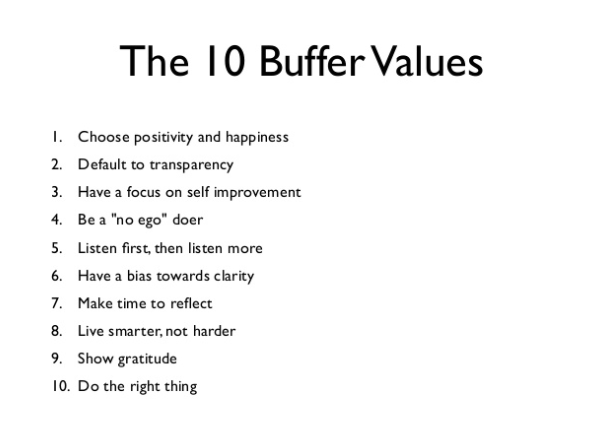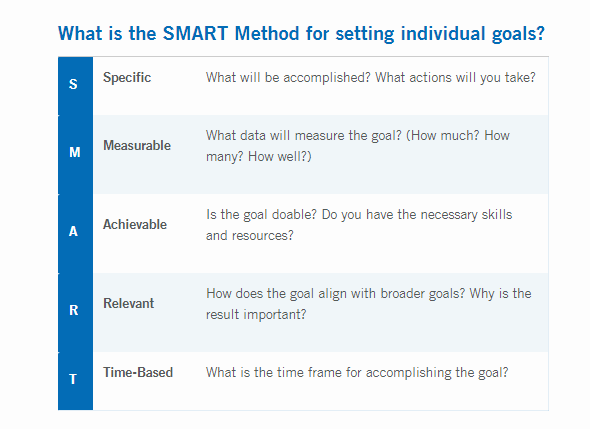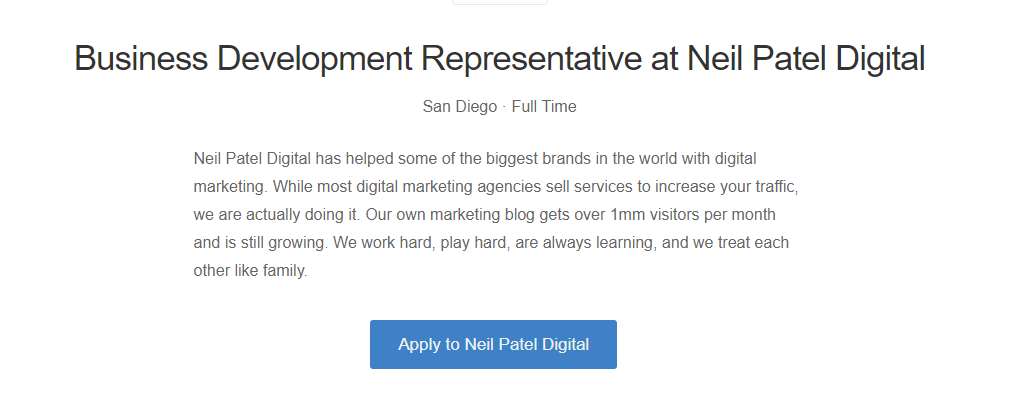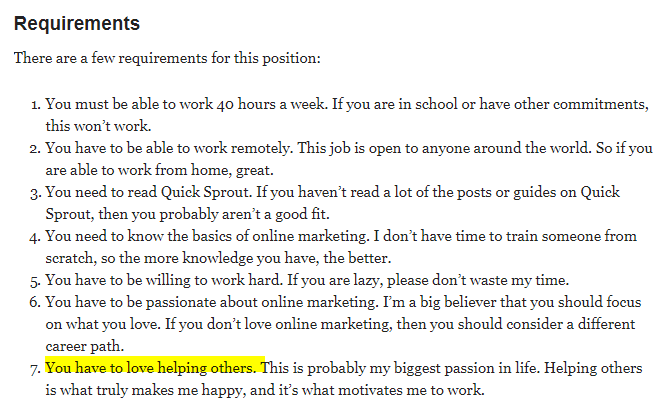Over the past decade, I’ve built dozens of teams. Some of them, like the team at Kissmetrics, were very successful.
Some of them, like the team at Kissmetrics, were very successful.
Others, like the teams I built when I was just getting started, were not as successful.
In most cases, those failures were due to mistakes I made in hiring and managing the team.
There is a secret that most startup founders and business owners don’t realize:
A leader isn’t the person who creates a successful business — it’s the rest of the team.
Seriously, the best leader in the world can’t build a successful business alone.
They need good people to get the work done.
The late Steve Jobs said it best: “Great things in business are never done by one person. They’re done by a team of people.”
I truly believe that building and growing a solid team is the most important part of creating any business.
Whether you want to build an SEO empire or sell Cuban sandwiches at your corner deli, the only way you will succeed as a business owner is by growing and nurturing a happy group of smart people.
Wait a second. Happy?
Yes, part of building a successful team is building a happy team.
Why? Because a happy team is a more productive team.
A recent study showed that happier workers are up to 10% more productive at work.
You might not be able to buy happiness, but happiness can help you make a better profit!
Think about the last time you got into what many people call a ‘flow state’ at work. It’s when you start a task and barely look up from your computer screen until the task is complete.
Maybe you were jamming to your favorite music or listening to your favorite productivity track, such as Coffitivity.
Either way, when you finally came up for air, you were surprised to find that an hour or more had passed.
Time flies when you’re having fun, as they say.
Now, think about the last client you had (or maybe even still have) who you dreaded working for.
It is a well-known feeling, based on the 12 million search results for “how to stay motivated when you hate your job.”
Your client might have paid really well, which is why you didn’t fire them, but working on the account felt like walking through hot sand.
Every step was painful and slow.
It goes to show that money isn’t necessarily the best motivator.
Paying your team really well isn’t always the answer.
Which is a good thing, because if it were many bootstrapped brands would have never made it off the ground.
To be successful, your team needs to be intrinsically motivated or driven by something inside themselves.
W. Edwards Deming, the famous engineer, had this to say about intrinsic motivation: “Monetary rewards are not a substitute for intrinsic motivation.”
So, how do you create a team that is motivated not by money, but intrinsically?
By keeping your team in alignment.
Okay, but what does that mean?
The Business Dictionary defines alignment as, “[The] linking of organizational goals with the employees’ personal goals. Requires a common understanding of purposes and goals of the organization, and consistency between every objective and plan.”
Keeping your team in alignment means making sure the company’s goals and your team’s goals are in sync.
It means getting your team members to emotionally buy into your company’s path.
Let’s say, for example, your goal is to grow traffic to your site by 200% in the next six weeks. (Which is totally possible, I did it at Crazy Egg.)
It’s a lofty goal. How do you make it happen?
By making sure your entire team is aligned.
When the entire team is aligned, your business will grow.
Let’s look at a few strategies for creating a team that is aligned with your company’s goals and that stays strong as you work toward those objectives.
Build a company culture of transparency
One of the most rewarding parts of building a company is creating the company culture.
Creating a space where highly skilled, innovative people can thrive is a challenge, and it sounds a bit abstract.
One of the best ways I have found to create a successfully aligned group is through transparency.
Transparency sounds a lot like a buzzword, doesn’t it?
Cognizant, a business technology company, makes transparency one of its core values:
So what does it mean in the real business world?
If we cut through all the buzzwords and “hacks,” transparency is about being a real, approachable human.
It isn’t about personality tests, trust falls or corporate retreats.
It’s about being a real leader and creating real connections with the people you hire to work for you.
Buffer is one of the best-known examples of transparency in our industry.
In fact, transparency is #2 on Buffer’s list of values:
The benefits of transparency are two-fold—both your bottom line and your employees benefit from it.
How?
People don’t buy from brands. They buy from people. Being open and honest about your business allows customers to create a true human connection.
For your employees, it fosters a sense of trust and loyalty.
What does transparency look like in the real world?
Does it mean sharing every piece of information with your entire team?
No. You can (and should) still exert some control over the flow of information.
But, as Buffer does, you should make transparency your default position.
There are several topics about which you should always be transparent and straightforward.
Pricing
Explain all the costs up front, including how and what customers will receive for the agreed-upon cost. Don’t try to hide behind complicated if-then statements.
Outline what you charge succinctly. Don’t stray from that price.
MailChimp creates a great example of this with its “forever free” pricing.
They also outline their paid programs clearly so you know exactly what you will get at each level.
Guarantees
Any product or service should come with a guarantee of quality or satisfaction. Why? Because a good guarantee not only inspires trust, but it actually increases conversions.
For example, here is Crazy Egg’s guarantee:
No double speak, no asterisks, and no ifs or buts.
It clearly states what the guarantee is, and we stand by it.
The truth is that, if you offer a top-notch product or service, it doesn’t matter how ‘crazy’ your guarantee is because it won’t get used very often.
Failures & Changes
If you as a leader have failed your team, you need to own up to it. If your business as a whole has failed, fix the mistake and make it right.
Be transparent about mistakes, fixes, and shifts.
If your business needs to make a change, offer your team and your customers an explanation, like Netflix did when they decided to separate their DVD and streaming services in 2011.
In fact, I suggest building a plan for when mistakes do happen instead of waiting until a problem arises. Successful businesses are made of people, and people make mistakes.
Expectations
Does your team know what you expect of them? Do your customers know what to expect from your product? By being clear about expectations, you create a culture in which people know where they stand.
The County of San Mateo uses the SMART method to set expectations of their employees.
This cleverly named process helps outline expectations clearly. When expectations are made clear, alignment comes naturally.
Transparency is a simple shift that can have a dramatic impact on your bottom line.
Making more money is great, but transparency is just the right way to do business.
A business founded on transparency helps everyone involved — customers, employees, and shareholders.
Hire people who are smarter than you
As a founder or leader of a business, you are often surrounded by people who are eager to tell you how smart you are.
Whether they are looking to gain something from you or really just think you are awesome, it is a trap you need to avoid falling into.
The best leaders know to hire people who are smarter than themselves.
For example, I am good at SEO, Google Adwords, email marketing, lead gen, and about a dozen other marketing strategies.
I am not good at sales — one of my first jobs was selling Kirby vacuums. I sold exactly one vacuum, which was later returned.
Instead of focusing on sales, I hire highly-skilled salespeople who are hungry and hoping to grow.
We share our culture and our resources and then we let them do the work.
Hiring people who are smarter than me means I don’t waste my time micromanaging my team, which saves us both time and energy.
Instead, I hire people who are experts in their fields, who want to learn, and who understand our culture. I let them do what they are good at.
Here is an example of one of my old job listings for Quick Sprout. The requirements and culture are clear and easy to understand.
You’ll notice that the listing doesn’t include a requirement for a fancy degree or specific certifications.
I hire people who are smart and knowledgeable, and I have full faith that they know or can figure out the best way to get the work done.
But do not confuse this approach with being totally hands-off.
To keep your team aligned, you need to be involved in setting goals and expectations, which I will dig into next.
Set expectations and let your team do the work
Part of letting my team do the work is setting clear expectations.
Most businesses do this occasionally, but they fail to apply it to everyday work.
For example, as a business owner, you might decide you want to get 300 Instagram followers in order to compete with companies like Moz.
Or you might decide that you want to increase your Facebook fans.
Should you build your fan base organically or buy new fans? Since we’re talking about transparency here, I think you know the answer.
If you are not a social media marketer, you might not have any idea how to actually make social media work for your business.
What is your next step?
Do you begin to outline a plan? Or do you set the expectation and let your team do the work?
Let’s back up a bit.
How did you decide on the 300 Instagram follower goal?
What if, instead of outlining a specific goal, you allowed your team to create their own goals?
Let’s walk through how this might work.
You own a catering company. During the past 15 years, you have built your business from a weekend gig to a million-dollar business that employs 25 people, including a 5-person marketing team.
Through research, you have seen that Instagram converts well for businesses like yours, including a geographic competitor in the BBQ catering niche.
You’d like to increase your number of Instagram followers because your research shows that this has the ability to increase overall revenue by as much as 20%.
You have done your research, but you are also not an Instagram expert.
What are the benefits of allowing your team to give their input on your new objectives?
First, it increases the likelihood of creating an attainable goal.
Is 300 Instagram followers a day even attainable? How can you make sure those followers lead to conversions?
Setting expectations alongside the people you hire to do the work (because they are smarter than you, as you might recall) means that you are able to set a realistic goal.
And you can make sure you have the follow-through to reach your real goal, which, in this case, is to increase the total conversions from social media to catering bookings.
Second, you reduce the expectation gap.
The expectation gap is the difference between what you think your team is responsible for and what they themselves believe they are responsible for.
When your team is involved in setting expectations, they have a clearer understanding of what those expectations are.
Finally, input from your team eliminates ambiguity. When your team is part of the process, they are better able to clarify expectations by asking questions.
You can also use clarifying statements to eliminate miscommunication. For example:
“To clarify, we are discussing the implementation process for increasing our Instagram followers by 300 followers per day. We plan to do this by implementing a contest, posting 3 times per day, and following 250-300 related accounts per day.”
Motivation requires more than just money
Part of keeping your team aligned means making sure your team is motivated to do good work.
Large companies have an entire human resource department that’s dedicated to finding, hiring, and retaining top candidates.
Startup founders and entrepreneurs do not have those same resources.
Which means that, as an entrepreneur, you need to learn at least a few basic HR skills all on your own.
One of the most basic HR lessons you need to learn is that money isn’t everything.
It matters, of course. I did do an entire experiment on spending money on clothing.
You can’t pay thousands of dollars below the industry standard and expect to attract the best computer programmers.
But money isn’t the only way to motivate your team.
Think about the last time you took on a challenge at work. What motivated you to overcome the challenge?
Was it money? Or something else?
Let’s say, for example, you are a QlikView developer for a large corporation.
QlikView is an application that allows companies to sort through and display analyses of large amounts of data.
You boss is notified that some of the numbers in one of the reports are incorrect.
After several hours of digging, including time over the weekend, you determine that a very small mistake in the coding was causing the issue.
What motivated you to figure out the issue?
Were you motivated by money? Your salary didn’t change even though you worked extra hours.
Or were you motivated by something other than money?
Perhaps you enjoy figuring out puzzles, or perhaps your job lets you work from home.
Maybe you are hoping for a promotion when the team lead position opens up.
Or maybe you just like being the team member people turn to when there is a major issue.
When you are first building your team, you likely can’t afford to pay a rate higher than larger corporations.
And just because you have the money doesn’t mean you should spend it (particularly if you got the money through VC funding!)
Consider less costly methods for motivating your team, including:
Employee benefits, such as the ability to work remotely, providing unlimited time off, instituting bring-your-pet-to-work days, offering free lunches, creating paid parental leave, and promoting from within.
Empower your team by giving them a voice in setting goals, choosing new training programs, creating new initiatives, and purchasing items that affect them, such as new office furniture.
Offer your employees incentives, such as earning extra PTO, tickets to a sports game, gift cards, or awards.
As an entrepreneur or startup founder, keeping your team aligned may require a bit of creativity. But the benefits will far outweigh the investment.
Conclusion
When you are first building your company, hiring might seem like an overwhelming process.
It might seem important to quickly hire someone — anyone — who can answer the ringing phone or fill those orders.
However, if you want to build a successful business, you have to start with a successful team.
And the root of any successful team lies in how they are built and how they are treated.
Being a leader is not about being the cool boss who everyone likes.
It is not about being the iron-fisted boss who everyone fears.
It is about hiring the best people, getting them aligned with your business goals, and then giving them the tools they need to be successful.
Have you built or been part of a successful team? What did you find to be the most vital aspect of your success?


















Comments (0)